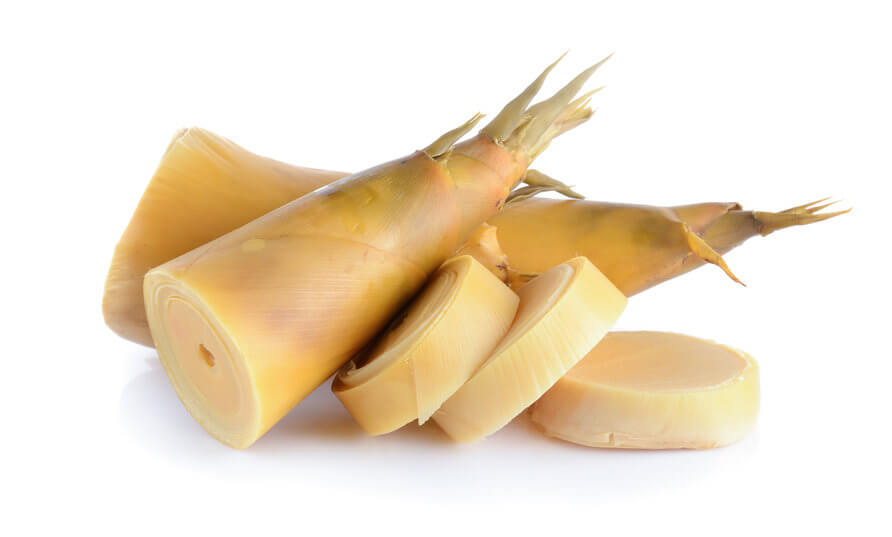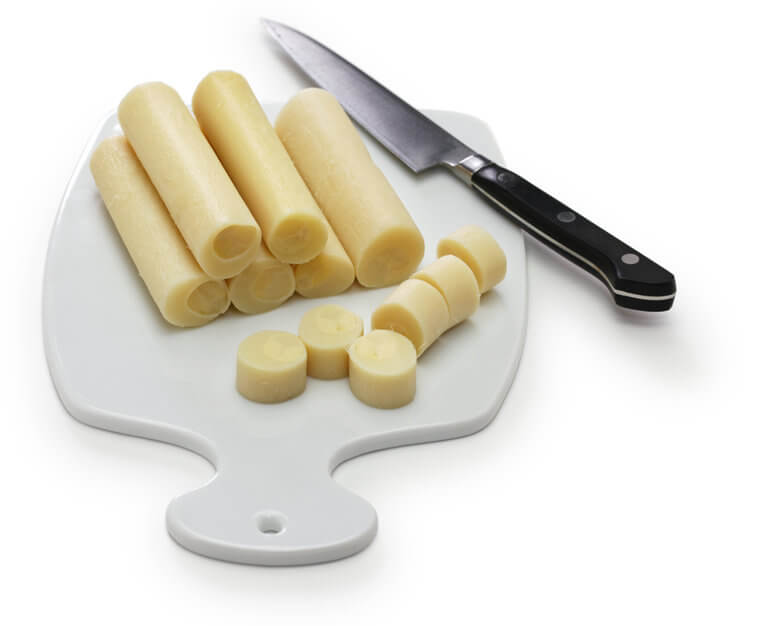Bamboo shoots and hearts of palm both come from exotic plants that originate in tropical climates. They’re also a hearty source of plant-based nutrition. But how do they stack up when compared with each other, though? If you’ve ever wondered the answer to that question then today you’re in luck, because in this article we’ll be pitting bamboo shoots vs hearts of palm to see how they compare.
In short, the difference between bamboo shoots vs hearts of palm is that palm hearts have more fiber, more protein, and more vitamins and minerals. Bamboo shoots, on the other hand, contain less calories, carbohydrates, and more potassium per serving.
Let’s explore these details further.
What Are Bamboo Shoots?
Bamboo shoots are the edible shoots of bamboo plants. There are many different varieties of bamboo, and each one has a unique flavor.

Bamboo shoots are often used in Asian cuisine and can be found in fresh, canned, or pickled varieties. They are commonly used in the following ways:
- In stir-fries
- In soups
- In salads
- And more
When preparing raw bamboo shoots it is necessary to peel them from their outer casing as it is inedible.
It should also be noted that one significant difference between bamboo shoots vs hearts of palm is that raw bamboo shoots require thorough cooking before consuming. This is done to destroy a toxin contained within, known as cyanogenic glycoside.
What Are Hearts Of Palm?
Hearts of palm (also known as palm hearts) are the innermost core of a palm tree. They are removed from the rest of the plant, and, unlike bamboo shoots, can be eaten raw if desired (although it may have a coarse texture that can prove difficult to chew and digest.)

Palm hearts are usually sold canned or jarred and can be found in the international aisle of most grocery stores. Like bamboo shoots, they’re also a good source of plant-based nutrition and are commonly used in a variety of Asian cuisines.
Additionally, heart palms have a somewhat mild, earthy tase; whereas bamboo shoots have more of a sweet flavor.
Hearts of palm are commonly used as a salad topping, but they too can be used in soups and various Asian cuisines, and the benefits associated with consuming them are vast and wide.
Bamboo Shoots VS Hearts Of Palm
Now that we’ve done a brief introduction to bamboo shoots and hearts of palm, let’s see how their nutritional contents compare with each other.
The following table compares the nutrition facts of prepared bamboo shoots that have been peeled, boiled and salted, with that of canned heart palms that have been prepared similarly:
| Item | Bamboo Shoots | Hearts Of Palm |
| Serving Size | 1 Cup (120g) | 1 Cup (146g) |
| Calories | 13.2 | 40.9 |
| Total Carbohydrates | 1.8g | 6.7g |
| Total Sugar | 0g | 0g |
| Added sugar | 0g | 0g |
| Dietary Fiber | 1.2g | 3.5g |
| Total Fat | 0.3g | 0.9g |
| Protein | 1.8g | 3.7g |
| Potassium | 640mg | 258mg |
| Vitamin C | 0% DV | 19% DV |
| Iron | 2% DV | 25% DV |
| Magnesium | 1% DV | 14% DV |
| Zinc | 4% DV | 11% DV |
| Copper | 5% DV | 10% DV |
It only takes a quick glance at the table above to see just how much more advantageous hearts of palm are when compared with bamboo shoots. Let’s elaborate.
Bamboo Shoots Have Significantly Less Calories
Possibly the greatest advantage of opting for bamboo shoots is that they contain less calories per serving, meaning you can eat a greater volume of food for less calories.
Calories are important because they’re the unit of measurement used to gauge the energy we consume and expend. In fact, whether we lose or gain weight depends entirely on the amount of calories we consume, according to Mayo Clinic.
If lowering your caloric intake is a priority for you then bamboo shoots would be the wiser option as they contain only 13.2 calories per 1-cup serving, compared to the 40.9 calories found in a similar serving size of palm hearts.
Palm Hearts Contain Triple The Fiber
One area where hearts of palm has a leg up on bamboo shoots is when it comes to fiber.
Fiber is an indigestible carbohydrate that is used to remove waste from the body. According to Mayo clinic, fiber can help…
- Maintain bowel health
- Lower cholesterol
- Control blood sugar
- And more
Not only do palm hearts have less calories per serving, but they also have nearly triple the fiber too, clocking in at 3.5g per 1-cup serving.
Palm Hearts Have More Protein
Protein is an essential macronutrient that’s used by the body to build and repair tissue, according to the Harvard School Of Public Health website. Proteins consist of amino acids and serve many other functions in the body aside as well.
Protein is often recognized as the building block of muscle mass. Athletes and fitness enthusiasts alike looking to maintain or improve their muscle mass require adequate protein intake every day.
Fortunately, hearts of palm have you covered as they contain 3.7g of protein per 1-cup serving, which is nearly double the amount found in a similar serving size of bamboo shoots.
More Vitamins & Minerals As Well
Finally, hearts of palm contain far more vitamins and minerals than bamboo shoots do, including:
- Vitamin C
- Iron
- Magnesium
- Zinc
- Copper
- And more
Each of these micronutrients help to serve critical metabolic functions in the body, and when you opt for palm hearts over bamboo shoots, you’ll enjoy the benefit of consuming far more of them.
Bamboo Shoots Have More Potassium
Now that we’ve gone over some of the reasons why palm hearts are preferable, let’s have a look at a couple of areas where bamboo shoots have the upper hand, starting with potassium.
Potassium is an essential electrolyte and mineral that is responsible for managing fluid balance in the body, as well as central nervous system function. Potassium may also play a role in managing blood pressure, according to the Harvard Health Publishing website.
Possibly the greatest advantage bamboo shoots have over hearts of palm is that they contain more than double the potassium, clocking in at 640mg per 1-cup serving, compared with the 258mg found in a similar serving size of palm hearts.
Bamboo Shoots Also Contain Less Carbohydrates
Another modest benefit of bamboo shoots is that they contain less carbohydrates per serving than palm hearts do.
This is important for those who may be following a ketogenic (or “keto”) diet, where carbohydrate calories are displaced with calories from fat and protein.
One of the most challenging aspects of following a keto diet is that it can be difficult to get adequate fiber intake, as fiber comes from plant-based foods — most of which are relatively high in carbs.
Clocking in at only 1.8 grams of carbohydrates per serving, bamboo shoots are an excellent choice. Not only are they low in carbs, but the few carbs they do have come mostly from fiber, meaning they have even less net carbs.
The Bottom Line
Choosing between bamboo shoots vs hearts of palm boils down to preference. Each vegetable has much to offer in terms of nutrition. If calories are your priority then bamboo shoots offer the most food for the least amount of calories. Hearts of palm, on the other hand, pack more fiber and protein. Choose accordingly and enjoy!

